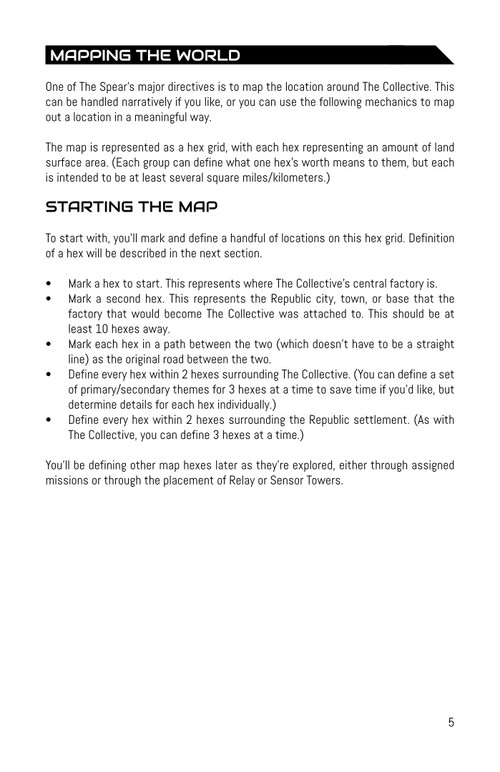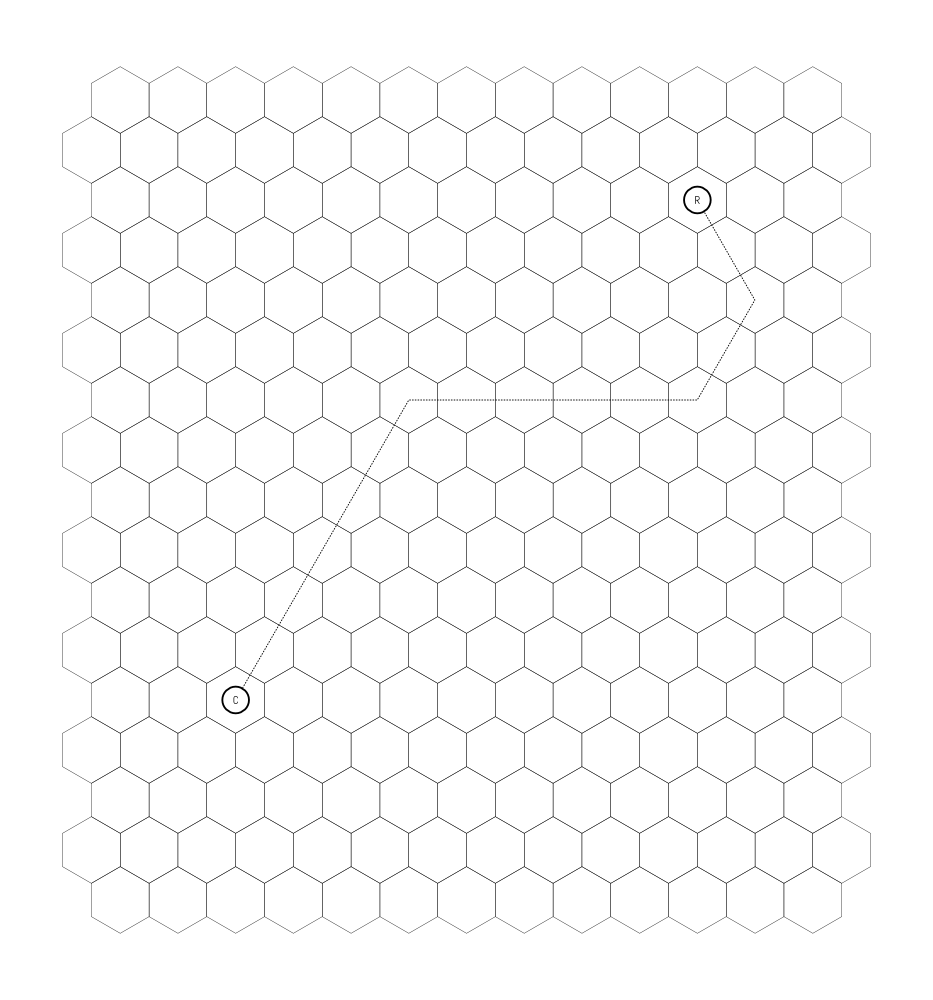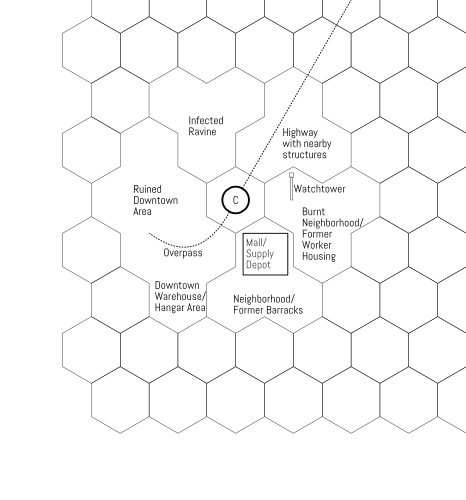Wilderness: Mapping the Infected World

Hi there! I’m going to show how the map for Wilderness works. The goal of the map is to provide a tangibility to the world itself and inspire the fiction of a mission.
Placing the two main hubs
The first step is defining where The Collective and whatever the nearest Republic city, town, base, or settlement is. (There could also be more than one, but there should be at least one prominent one - it was a factory, after all.)
To start, we define hexes for each (R and C on this map) and draw a road (dotted line) between the two. The road doesn’t have to be fully direct, so ours won’t be.

And to zoom in on The Collective (because that’s what we’re focusing on):

Defining hexes
Defining a hex involves 3 rolls (or choices, as the case may be):
- Determine the Primary Theme
- Determine the Secondary Theme
- Check for major details
Themes are all done via d6 rolls on the below table:
- Infected or Wasteland. Mutated or alien wilderness, with flora and fauna unrecognizable, or an area forcibly scoured.
- Overgrown. An explosion of flora, abandoned and untamed, with fauna to match. Maybe a forest or jungle.
- Elevation Change. Some major change in elevation, enough to it difficult for most vehicles to pass. Maybe hills, a mountain, a ravine, or a sinkhole.
- Flat Area. A manmade or natural flat area, like a pasture or a disconnected, old freeway.
- Ruins. A building, set of buildings, or set of vehicles that’s been destroyed and abandoned. People might still live here.
- Settlement. Untouched pre-Infection structures or rebuilt structures. It’s likely that someone lives here, or that it’s being used as a base or outpost. This could potentially be a major settlement.
Detail is a similar die roll, but only 1’s and 6’s matter. A 1 means some natural or alien landmark (like an enormous tree, or a river, or some alien plant that’s taken root). A 6 means some manmade landmark (like a monument, a major road, or a prominent building).
For areas close to a major settlement (The Collective and that adjoining Republic settlement count), roll twice and take the higher for Primary Theme and Detail. For areas further out, roll twice and take the lower for Primary Theme and Detail. For areas that are in between, roll one die for Primary Theme and Detail. (Secondary theme is always one die.)
Mapping The Collective
For each of these two major settlements we’re defining from the outset, you’re supposed to define everything within 2 hexes of each settlement. In theory, you could do 18 of these, but it’s strongly suggested you do 6 of these and apply them to 3 hexes each (rolling Details individually though for each of those 3 hexes). We’ll just do The Collective right now.
I’ll lay this one out fully so it’s clear and skip to the rolls/results for the other 5.
- Primary Theme: 2d6 = (6, 1) = 6 for Settlement.
- Secondary Theme: 1d6 = 4 for Flat Area.
- Details: 2d6 = (6, 2) = 6, 2d6 = (3, 3) = 3, 2d6 = (4, 5) = 5 for one manmade detail between the three hexes.
We’ll define this as what used to be a suburban tracked-housing neighborhood, possibly originally designed as homes for workers of the factory that would become the Collective, or possibly long before that. The manmade detail is that they’re built around a big shopping mall, since turned into some kind of depot.
And for the others:
- 3, 1, 5, 3, 3. Elevation change primary, infected/wasteland secondary, no details. We’ll say this is a huge ravine where Infected materials were quarantined when the area around the factory was retaken. Nobody goes there, for the most part…and who knows if The Republic was fully successful in containing it.
- 4, 6, 4, 4, 4. Flat primary, settlement secondary, no details. This is probably a good one for the stretch of highway leading out of the area, with roadside buildings that were kept in good shape by Republic forces.
- 6, 5, 6, 2, 6. Settlement primary, Ruins secondary, two manmade details. We’ll now decide that The Collective wasn’t always a factory, maybe it was a bigger town that was converted into a factory area (and that first residential area was suburbs). This was the more downtown/city center kind of area, albeit with a few districts leveled from fighting, largely converted into warehousing and hangars using the intact infrastructure. The two manmade details are a major overpass that stretches across two hexes, leading to the highway out of town and to destroyed areas that no longer exist.
- 5, 5, 5, 5, 4. Ruins primary/secondary, no details. This was an portion of that downtown area that got fully destroyed. The overpass used to lead here, but it was broken off when the rest of it was destroyed years ago.
- 6, 1, 3, 5, 6. Settlement primary, infected/wasteland secondary, one manmade detail. An settlement in a burnt-out area sounds like where you’d keep a prisoner-based workforce - we’ll say that the previous residential area had been used as barracks for Republic guards keeping the factory running, whereas this was a similar, adjoining neighborhood that was half-destroyed to prevent an Infection outbreak and was subsequently “restored”. The manmade detail is a watchtower constructed to keep an eye on workers, now used to keep an eye on the road.
So this is what the map looks like now!

(And you’d repeat this for the Republic settlement.)
We’ve constructed a narrative around The Collective from these rolls! This hex-definition method is used both at the start of a campaign and during a campaign: every time a mission is located outside The Collective at an unknown area, that hex is defined. This not only provides some immediate hooks for a mission but also helps create a greater sense of permanency over time.
Check out The Infected World if this was of any interest to you! There’s some extra stuff attached to this, but you’ll have to get it to see what it is. I’ll be expanding these mechanics further with subsequent modules as well.
Until next time!
Get APOCALYPSE FRAME: The Infected World
APOCALYPSE FRAME: The Infected World
The first season pass for APOCALYPSE FRAME. Explore a ruined world.
| Status | Released |
| Category | Physical game |
| Author | Binary Star Games |
| Tags | lumen, mecha, Mechs, Tabletop, Tabletop role-playing game |
More posts
- As promised, the compilation is (finally) here!Jun 14, 2023
- Trophy release!Jul 06, 2022
- Caravan Release!May 31, 2022
- Territory Release!May 03, 2022

Leave a comment
Log in with itch.io to leave a comment.